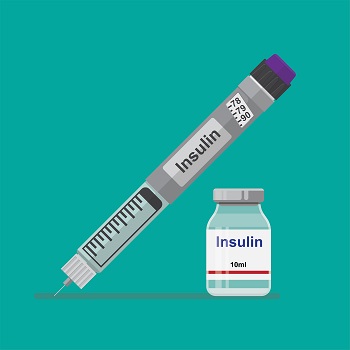Differentiating type 1 from type 2 diabetes in adults
Type 1 diabetes can be challenging to diagnose after childhood in part because the overt symptoms tend to be milder.
Type 1 diabetes is often considered a disease of childhood, but it can appear in adults more often than previously thought. A recent study published in September 2023 in Annals of Internal Medicine found that 37% of adults with type 1 diabetes in the United States didn't receive their diagnosis until after age 30.
"We didn't previously have national data to fully understand how the age of type 1 diagnosis differs at a population level, so we assumed that it was a largely childhood disease," said Michael Fang, PhD, MHS, lead author of the Annals paper and assistant professor at the Johns Hopkins Bloomberg School of Public Health in Baltimore. "We're now getting a better picture, though, because of better data and information."

Often called latent autoimmune diabetes of adults (LADA), type 1 diabetes diagnosed in adults presents a conundrum for the busy clinician.
"The reason it's relevant to know what kind of diabetes someone has is because how you treat it is going to be incredibly different," said Fatima Zahara Syed, MD, MSc, FACP, an internal medicine physician and associate professor of medicine at Duke University Health System in Durham, N.C. "It's going to be oral medications versus absolutely having to have insulin."
While type 2 diabetes usually occurs gradually, with many patients with overweight or obesity showing signs of prediabetes for years, the onset of type 1, no matter a person's age, can be very sudden. But compared with adults, children tend to present with more traditional symptoms: frequent urination, excessive thirst, unintentional weight loss, fatigue, and even diabetic ketoacidosis.
"This is what makes type 1 diabetes diagnosis challenging in adults," Dr. Fang explained. "The overt symptoms tend to be milder, making it hard to distinguish from type 2 diabetes."
Another challenge is that patients with type 1 have not traditionally had overweight or obesity, but many of them now often do given the increasing presence of these conditions, according to Dr. Syed. "It's very easy to put people in buckets, [but] you have to avoid doing that," she said.
It's no wonder many primary care physicians struggle with diagnosing LADA, since medical students are often taught that the "vast majority" of adults diagnosed with diabetes will have type 2, said ACP Member Caroline Sloan, MD, also an internal medicine physician and assistant professor of medicine at Duke. "I honestly don't really remember learning about evaluating people for type 1 diabetes when they have a new diagnosis of diabetes as an adult," she said.
She recommended scrutinizing patients' personal or family history of autoimmune disease, as LADA is often thought to be sparked by an autoimmune reaction. Also, she said, "If they present with diabetic ketoacidosis or with unintentional weight loss, that's oftentimes a clue that what they have is type 1 diabetes rather than type 2 diabetes." If they're not responding to medications typically used for type 2 diabetes, like metformin or a sulfonylurea, that should be another clue, she added.
It's important to also heavily consider genetic predisposition for type 1 itself, as well as medications a patient is taking that might contribute to their risk, such as certain immune-modulating medications for cancer, including tyrosine kinase inhibitors, Dr. Syed added.
Ultimately, she advised, "If you are doing all the things and the patient is doing all the things and their diabetes is still not controlled, that is something to trigger [testing for type 1] as well."
These tests include checking for islet autoantibodies, like glutamic acid decarboxylase 65 (GAD-65), as well as low C-peptide levels, Dr. Sloan said. She also urged physicians to maintain a high suspicion for type 1. "I imagine I may have missed some cases of type 1 diabetes in my short career because I didn't really think about it," she said.
She reflected on a recent patient in her clinic, a man in his 50s or 60s who had a long history of type 2 diabetes but was eventually found to have adult-onset type 1 diabetes. "No one had ever evaluated him [for type 1], and so he was on all sorts of medications but not responding to them," Dr. Sloan explained. "No one really understood why until he saw an endocrinologist," adding that the patient now has a better quality of life because his diabetes is well controlled and he's on insulin at a proper dose.
"You don't want to be the person, although I'm sure it happens to all of us, who sends someone to endocrinology because a patient has uncontrolled type 2 diabetes, and then you didn't check for type 1 and that's what they had," she said.
As in many facets of medicine, health disparities could play a role not only in who might be diagnosed with diabetes but also their care and treatment.
Dr. Fang said he and his team found "some differences in age of type 1 diabetes diagnosis by race and ethnicity" in their research, with non-Hispanic White patients being diagnosed earlier. "This may be related to worse access [for other races and ethnicities], which leads to a later diagnosis in adult type 1 diabetes cases," he explained.
There has been a proven link between the prevalence of type 2 diabetes and lower socioeconomic status, Dr. Syed noted. "But for LADA, I think the disparities come into access to diagnosis and then access to medications and the cost of medications. I don't think the social and structural drivers have to do with actually getting the disease," she said.
Dr. Sloan agreed. "The advice I can give is to just try and be as systematic as possible with every single one of our patients," she said. "We should all develop illness scripts where when an adult presents with new-onset diabetes, we should have that list of five or however many criteria in our minds that would lead us to test for type 1 diabetes and think about that list for every single patient, no matter what they look like or no matter what their income level is or their insurance."
A patient diagnosed with type 2 diabetes will inevitably be advised to make some lifestyle changes to control or even potentially eliminate their disease. While this prescription is different for those with type 1 diabetes, exercise and a healthy diet are still essential.
"Lifestyle changes are really important for people with type 1 diabetes in large part because the presence of diabetes puts people at far greater risk of heart disease and high cholesterol," Dr. Sloan said. "By implementing lifestyle changes, you will not cure yourself of your diabetes like people with type 2 can do, but you will help reduce your risk of heart disease."
Dr. Syed stressed that the biggest lifestyle changes for people with type 1 diabetes involve living with the disease day to day—watching their sugar intake and using the proper doses of insulin. Specifically, she said, eating a "healthier amount of carbs is important, just like it would be in type 2 diabetes."
In her experience, patients with diagnosed type 1 diabetes generally do an excellent job of managing their health. She encouraged physicians to support their patients in being self-advocates, both through activism and education. Last, Dr. Syed said, "I recommend all my patients keep a healthy weight and also make sure that they are on top of their other screenings."
Even with the right mindset and tools, Dr. Sloan said that the most important aspect of diagnosing type 1 diabetes may also be the most difficult: remaining on high alert and avoiding complacency.
"I see so many people who have type 2 diabetes that when I have a new patient with diabetes, I just oftentimes don't think about it [being anything else]; I just go through the motion of starting them on the treatment for type 2 diabetes," she said. "We need to incorporate into our practice at least thinking about type 1 and having a low threshold to test for type 1, since rates are rising."





